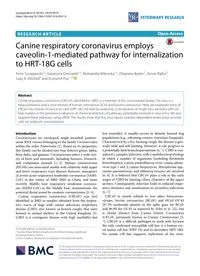
2018 Canine respiratory coronavirus employs caveolin-1-mediated pathway for internalization to HRT-18G cells PDF
Preview 2018 Canine respiratory coronavirus employs caveolin-1-mediated pathway for internalization to HRT-18G cells
Szczepanski et al. Vet Res (2018) 49:55 https://doi.org/10.1186/s13567-018-0551-9 RESEARCH ARTICLE Canine respiratory coronavirus employs caveolin-1-mediated pathway for internalization to HRT-18G cells Artur Szczepanski1,2, Katarzyna Owczarek1,2, Aleksandra Milewska1,2, Zbigniew Baster3, Zenon Rajfur3, Judy A. Mitchell4 and Krzysztof Pyrc1,2* Abstract Canine respiratory coronavirus (CRCoV), identified in 2003, is a member of the Coronaviridae family. The virus is a betacoronavirus and a close relative of human coronavirus OC43 and bovine coronavirus. Here, we examined entry of CRCoV into human rectal tumor cells (HRT-18G cell line) by analyzing co-localization of single virus particles with cel- lular markers in the presence or absence of chemical inhibitors of pathways potentially involved in virus entry. We also targeted these pathways using siRNA. The results show that the virus hijacks caveolin-dependent endocytosis to enter cells via endocytic internalization. © The Author(s) 2018. This article is distributed under the terms of the Creative Commons Attribution 4.0 International License (http://creat iveco mmons .org/licen ses/by/4.0/), which permits unrestricted use, distribution, and reproduction in any medium, provided you give appropriate credit to the original author(s) and the source, provide a link to the Creative Commons license, and indicate if changes were made. The Creative Commons Public Domain Dedication waiver (http://creat iveco mmons .org/ publi cdoma in/zero/1.0/) applies to the data made available in this article, unless otherwise stated. Introduction Coronaviruses are enveloped, single-stranded, positive- sense RNA viruses belonging to the family Coronaviridae within the order Nidovirales [1]. Based on its properties, this family can be divided into four distinct genus: alpha, beta, delta, and gamma. Coronaviruses infect a wide vari- ety of birds and mammals, including humans, livestock, and companion animals [1–3]. Human coronaviruses (HCoVs) are associated mainly with relatively mild upper and lower respiratory tract disease; however, emergence of severe acute respiratory syndrome coronavirus (SARS- CoV) in the winter of 2002–2003 in China, and more recently Middle East respiratory syndrome coronavi- rus (MERS-CoV) in the Middle East, demonstrates the potential threat posed by zoonotic coronaviruses [2–4]. Canine respiratory coronavirus (CRCoV) was first identified in 2003 in samples obtained from the respira- tory tracts of dogs with canine infectious respiratory disease (CIRD; also known as kennel cough) that were housed in animal shelters in the United Kingdom [5]. CIRD is a contagious disease with high morbidity but low mortality; it usually occurs in densely housed dog populations (e.g., rehoming centers, veterinary hospitals). Characterized by a dry, hacking cough, the disease is gen- erally mild and self-limiting. However, it can progress to a potentially fatal bronchopneumonia [6, 7]. CIRD is con- sidered a complex infection, with a multifactorial etiology in which a number of organisms (including Bordetella bronchiseptica, canine parainfluenza virus, canine adeno- virus type 1 and 2, canine herpesvirus, Mycoplasma spp., canine pneumovirus, and influenza viruses) are involved [6, 8]. It is believed that CRCoV plays a role in the early stages of CIRD by limiting ciliary clearance of the upper airways. Consequently, infection leads to reduced respir- atory clearance and sensitization to secondary infections [5–7]. CRCoV is closely related to two other betacorona- viruses, bovine coronavirus (BCoV) and HCoV-OC43 (97.3% nucleotide identity in the spike gene for BCoV and 96.9% for OC43 as reported by Erles et al. [5]), but is clearly distinct from Canine Enteric Coronavirus (CECoV, previously known as Canine Coronavirus) [5, 7]. CRCoV is a difficult pathogen to work with because the only confirmed susceptible cell line is a human rec- tal tumor cell line (HRT-18) and its derivative HRT-18G. No canine cell line supports replication of the virus. Open Access *Correspondence:
